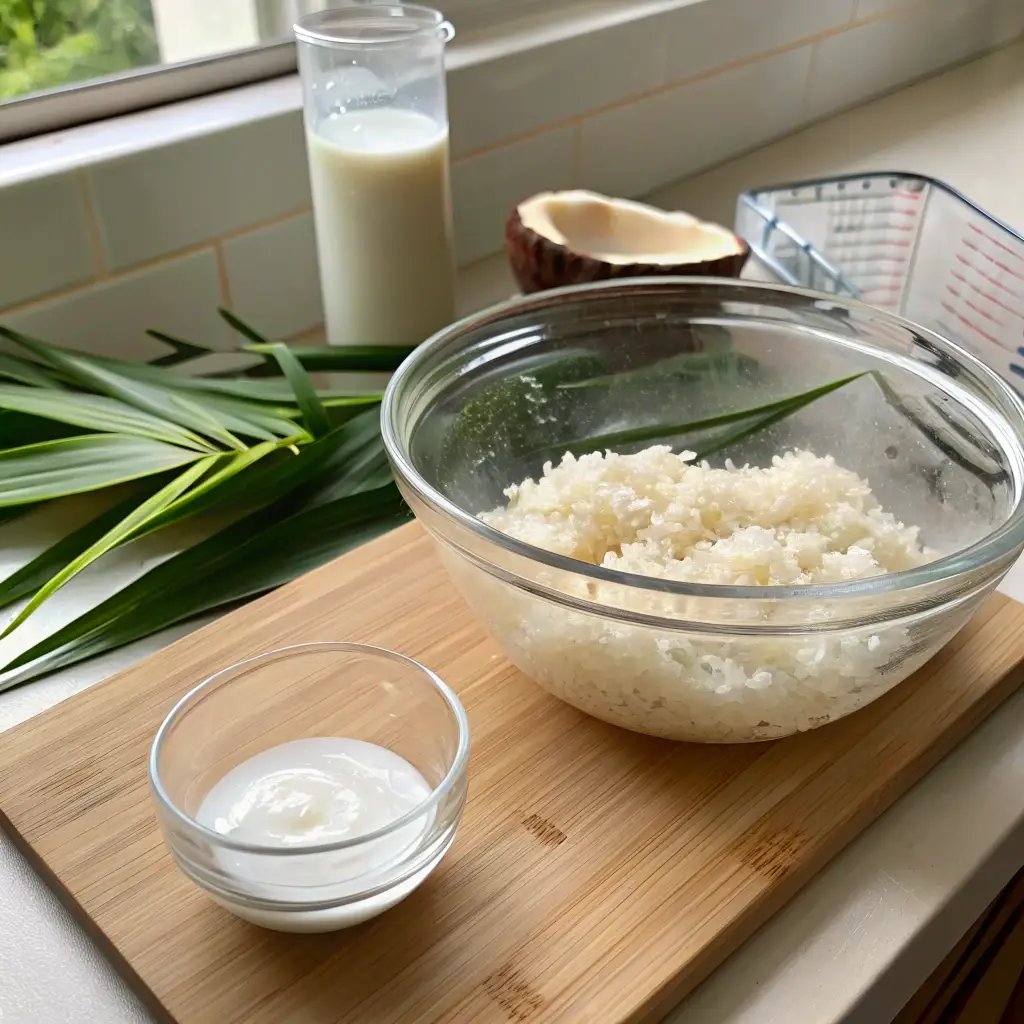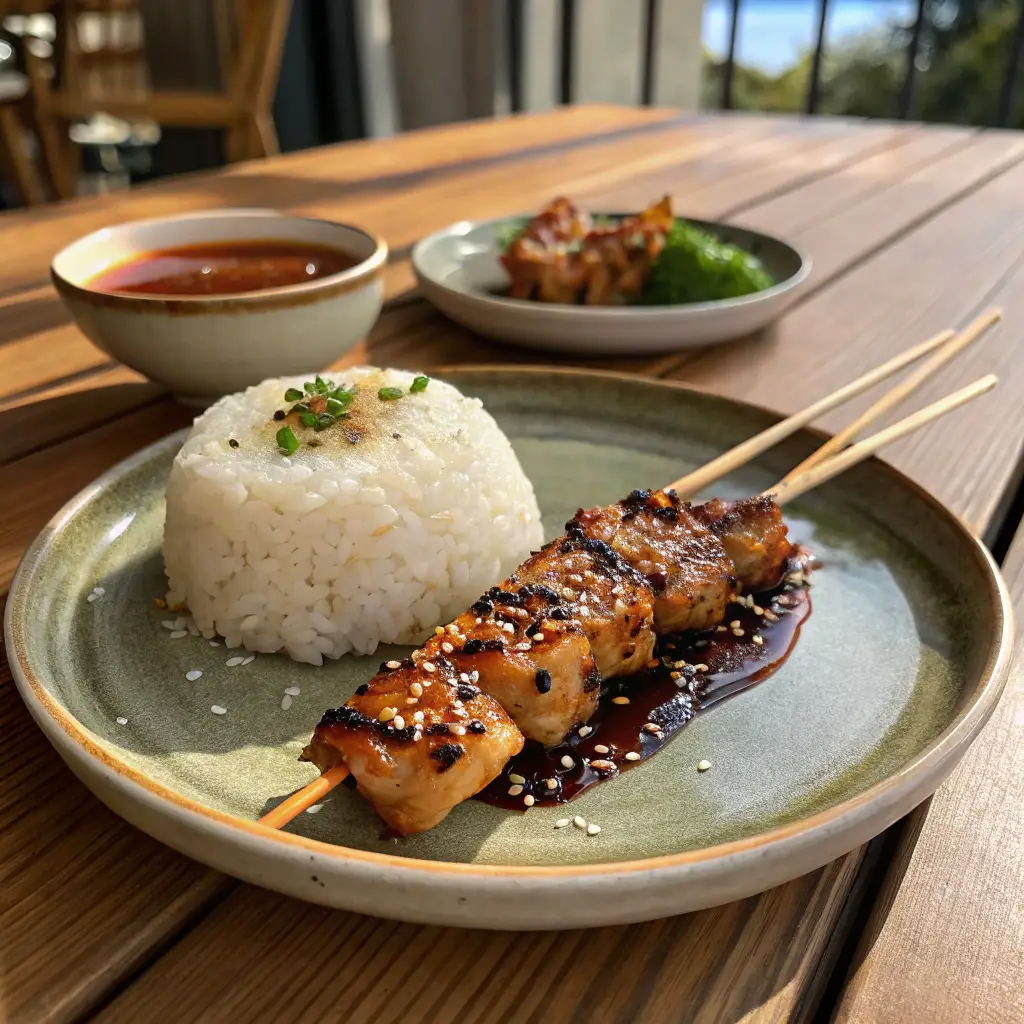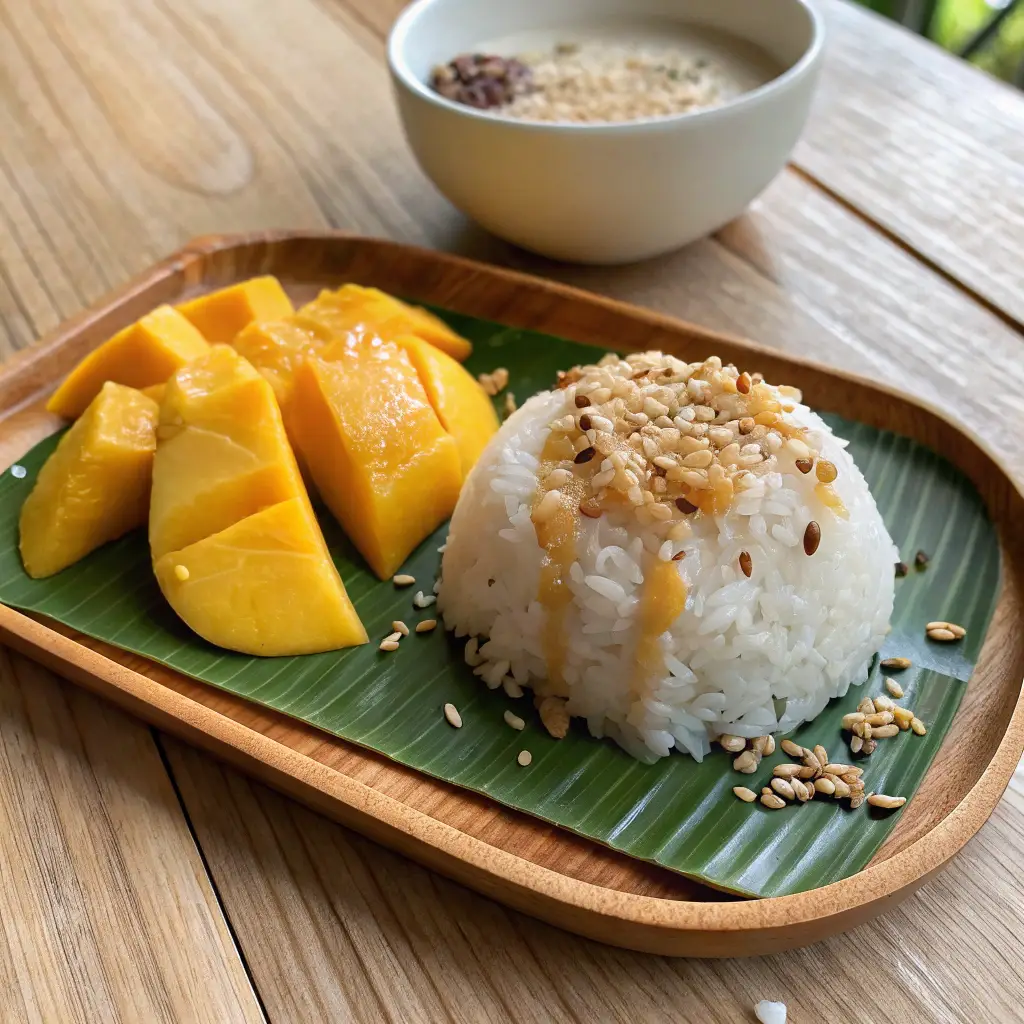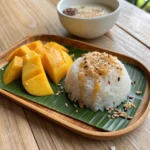Sticky Rice in a Rice Cooker is a game-changer for home cooks worldwide, especially in Asian households where this soft, chewy delight is a staple. Its subtle sweetness and perfect texture make it an unbeatable side for savory dishes or a dreamy base for sweet treats. But let’s be honest—getting that ideal sticky rice consistency can feel like a guessing game without the right tools.
That’s where your trusty rice cooker comes in! With just a little prep, this gadget becomes your go-to for consistently perfect sticky rice every single time.
In this guide, we’ll walk you through everything you need to know about making sticky rice in a rice cooker, from understanding what makes it unique to mastering prep, cooking, and serving tips. Let’s dive in and get cooking!
Table of Contents
Understanding Sticky Rice in a Rice Cooker and Its Significance
What Is Sticky Rice?
Sticky rice—also called glutinous rice or sweet rice—is a type of rice that becomes, well, sticky when cooked. Unlike regular long-grain rice, sticky rice contains a higher percentage of amylopectin, a starch that gives it that signature sticky texture.
Now, don’t let the name “glutinous” fool you. Sticky rice is 100% gluten-free, so it’s perfect for anyone following a gluten-free diet. Its plump grains cook up soft, almost translucent, and oh-so-satisfying.
Differences Between Sticky Rice and Other Varieties
If you’re used to fluffy jasmine or basmati rice, sticky rice might surprise you. It doesn’t separate into individual grains. Instead, it clumps together—perfect for scooping up with your hands or forming into balls. That’s why it’s a go-to for dishes where utensils aren’t always the norm.
Compared to other rice types:
- It has a shorter grain length.
- It requires soaking before cooking to soften its tough outer layer.
- It’s a bit sweeter, making it versatile for both desserts and savory meals.
Cultural Importance of Sticky Rice
Sticky rice isn’t just about the texture or taste—it’s about tradition. Across Southeast Asia, sticky rice is central to dishes like mango sticky rice in Thailand or bánh chưng in Vietnam. Families often cook it during festivals or special occasions, making it a food that brings people together.
For example, in Laos and Northern Thailand, sticky rice is a daily staple, often served in small woven baskets. It’s also used in rituals and ceremonies, symbolizing prosperity and unity.
Benefits of Using a Sticky Rice in a Rice Cooker
Convenience and Consistency
Let’s be real—life’s busy, and nobody has time to babysit a pot on the stove. That’s why a rice cooker is a game-changer. Whether you’re cooking dinner for one or feeding a crowd, it takes the guesswork out of making sticky rice.
A rice cooker simplifies everything. You just rinse the rice, measure the water, and press a button. No more worrying about uneven cooking or scorched bottoms. Plus, most modern rice cookers have “sticky rice” or “glutinous rice” settings, so you can hit that perfect texture with minimal effort.
Another bonus? It’s pretty foolproof. Even if you’re new to cooking, a rice cooker makes it easy to nail the texture every time. The machine handles the temperature and timing, so your rice turns out soft and clumpy, never mushy or undercooked.
Preserving Nutrients and Flavor
Did you know that a rice cooker doesn’t just make things easier—it also helps retain nutrients? Cooking sticky rice in a sealed environment traps the steam, which locks in the natural flavors and nutrients of the rice.
Compared to boiling in an open pot, where you lose some of the flavor in the water, a rice cooker keeps everything contained. This method ensures the rice stays aromatic and true to its natural taste.
What’s more, the consistent heat distribution means each grain is evenly cooked. No crunchy surprises or soggy spots—just perfect, flavorful sticky rice from start to finish.
Step-by-Step Guide to Cooking Sticky Rice in a Rice Cooker
Selecting the Right Type of Rice
The first step in making great sticky rice is picking the right kind. Not all rice is created equal, and you need to choose glutinous rice or sweet rice. These varieties are specifically grown for that sticky texture we all love.
When shopping, look for bags labeled “glutinous rice” or “sticky rice.” Popular brands like Three Rings or Golden Phoenix are widely available in Asian grocery stores or online. If you’re unsure, check the grain—it should be short and plump, not long or slender like jasmine rice.
Preparation Steps

Here’s where the magic begins. Before cooking, you’ll need to rinse and soak the rice. This step removes excess starch, which can make your rice too sticky (even for sticky rice!).
- Rinse the Rice: Place the rice in a bowl and cover it with cold water. Swirl it around, then drain. Repeat this 3–4 times until the water runs clear.
- Soak the Rice: Once rinsed, soak the rice in water for at least 4 hours, or even overnight if you have the time. Soaking softens the grains and helps them cook evenly.
Cooking Process
Now, let’s get cooking! Once the rice is prepped, transfer it to your rice cooker. For every cup of soaked sticky rice, use about 3/4 cup of water. The water-to-rice ratio is a bit lower than regular rice because sticky rice absorbs less water.
- Add the Rice and Water: Place the rice and water in the rice cooker. Give it a little stir to even things out.
- Set the Cooker: If your rice cooker has a “sticky rice” setting, use it. If not, the standard white rice setting works fine.
- Wait for the Magic: Let the rice cooker do its thing. Once it clicks to “warm,” leave the rice to rest for 10 minutes. This step helps the rice settle and reach the right texture.
Post-Cooking Tips
Once the rice is done, don’t skip the fluffing step. Use a wooden spatula or rice paddle to gently mix the rice, breaking up any clumps. This releases excess steam and ensures an even texture throughout.
And that’s it—you’ve got perfect sticky rice ready to serve! Whether you’re pairing it with spicy curry or using it for mango sticky rice, your rice cooker has your back.
Enhancing Your Sticky Rice in a Rice Cooker Experience
Flavoring Options
Sticky rice is delicious on its own, but why stop there? Adding a few simple ingredients can turn this humble dish into a showstopper.
One popular way to jazz up sticky rice is by cooking it with coconut milk. This method gives the rice a creamy, rich flavor that’s perfect for desserts like mango sticky rice. Just replace part of the water with canned coconut milk—about 1/4 cup per cup of rice works beautifully. Add a pinch of salt and sugar, stir it in, and cook as usual.
For a more aromatic twist, toss in a couple of pandan leaves while the rice cooks. These leaves are like vanilla for Southeast Asian cuisine—they add a subtle, sweet fragrance that pairs wonderfully with the rice.
Serving Suggestions

Sticky rice is incredibly versatile, pairing beautifully with a variety of dishes. Whether you’re serving it with spicy curries, grilled meats, or as a base for desserts like mango sticky rice, it’s a star on the table. For more recipe inspiration, check out this sticky rice pairing guide from Bon Appétit. It’s packed with creative ideas to make your meals even more exciting!
If you’re leaning toward sweet, sticky rice works wonders in desserts. Mango sticky rice is a crowd favorite—simply top the rice with fresh, ripe mango slices and drizzle with a sweet coconut sauce. Sprinkle a few toasted sesame seeds on top for an extra crunch.
Storage and Reheating
Got leftovers? Sticky rice stores well, but you’ve got to handle it right to maintain its texture.
- Storing: Let the rice cool completely before sealing it in an airtight container or a zip-top bag. Store it in the fridge, and it’ll keep for 3–4 days.
- Reheating: To revive the rice, steam it. Place it in a heatproof bowl, cover with a damp towel, and steam for about 5–10 minutes. Don’t microwave it dry—it’ll turn into a gummy mess.
If you’re in a hurry, you can sprinkle the rice with a bit of water, cover it with a damp paper towel, and microwave it for 30 seconds at a time. It’s not as perfect as steaming, but it’ll do in a pinch.
Sticky rice is incredibly versatile, pairing beautifully with a variety of dishes. From grilled meats to curries and even standalone rice dishes, the possibilities are endless. For instance, if you’re looking for a hearty and flavorful pairing, try our Chicken and Yellow Rice Recipe: A Flavorful Delight for Every Meal. It’s aromatic, filling, and works wonderfully with sticky rice as a side or a complement.
FAQs
Can I use any rice cooker to make sticky rice?
Yes, but the results might vary depending on the model. Rice cookers with a “sticky rice” or “glutinous rice” setting are ideal, as they adjust the cooking process for perfect texture. For standard models, carefully manage the water-to-rice ratio and follow the instructions for white rice.
Do I need to soak sticky rice before cooking it in a rice cooker?
Absolutely! Soaking is key to getting that signature sticky texture. It softens the grains, ensuring even cooking. Aim to soak your sticky rice for at least 4 hours—overnight is even better. Skipping this step may leave you with unevenly cooked or overly chewy rice.
What’s the ideal water-to-rice ratio for sticky rice?
The ratio is slightly lower than regular rice. Use 3/4 cup of water for every 1 cup of soaked sticky rice. This prevents the rice from becoming overly wet or mushy. If you’re experimenting, adjust the ratio slightly based on your rice cooker model.
How can I prevent sticky rice from becoming too mushy or too dry?
Consistency is all about balance. Too much water makes the rice mushy, while too little leaves it undercooked. Rinse and soak the rice thoroughly before cooking. Also, let it rest for 10 minutes after cooking to settle the moisture evenly.
Is sticky rice gluten-free?
Yes! Despite being called glutinous rice, it contains no gluten. The term refers to its sticky texture, not gluten content. It’s safe for anyone on a gluten-free diet, making it a versatile choice for diverse dietary needs.
Can I flavor sticky rice in a rice cooker?
Definitely! You can add coconut milk, pandan leaves, or even a pinch of salt and sugar to enhance the taste. Just mix your chosen ingredients into the water before starting the cooker, and you’ll get perfectly flavored rice.
How do I store and reheat sticky rice?
To store, cool the rice completely and seal it in an airtight container or zip-top bag. Refrigerate for up to 4 days. For reheating, steam the rice or microwave it with a damp paper towel to restore its texture. Avoid microwaving it dry.
Conclusion
Making sticky rice in a rice cooker doesn’t have to be complicated. With the right techniques, tools, and a little prep, you can create perfectly soft and chewy rice that pairs beautifully with both sweet and savory dishes. Whether you’re a beginner or a seasoned home cook, using a rice cooker takes the guesswork out of the process and ensures consistent results every time.
Throughout this guide, we’ve explored everything you need to know—from understanding what makes sticky rice unique, to prepping and cooking it with ease. We also covered ways to enhance its flavor, like adding coconut milk or pandan leaves, and provided tips on how to serve, store, and reheat it without losing its signature texture.
Now it’s your turn to give it a shot! Whether you’re craving mango sticky rice or planning to serve it with your favorite savory dish, your rice cooker is ready to help you bring a touch of tradition and flavor to the table. Remember, practice makes perfect, so don’t be afraid to experiment and make this classic dish your own.
PrintMastering Sticky Rice in a Rice Cooker: A Step-by-Step Guide
Learn how to make perfect sticky rice in a rice cooker with this simple and foolproof method. Whether you’re pairing it with savory dishes like grilled chicken or using it for desserts like mango sticky rice, this recipe guarantees soft, chewy, and flavorful sticky rice every time.
- Prep Time: 4 hours
- Cook Time: 20 minutes
- Total Time: 4 hours 20 minutes
- Yield: Serves 4
- Category: Breakfast,Dessert
- Method: Rice Cooker
- Cuisine: Asian
- Diet: Gluten Free
Ingredients
- 2 cups glutinous rice (sticky rice)
- 1 1/2 cups water
- 1/4 cup coconut milk (optional, for flavor)
- 1/4 tsp salt (optional)
- 1 pandan leaf (optional, for aroma)
Instructions
- Rinse the sticky rice thoroughly in cold water until the water runs clear.
- Soak the rice in water for at least 4 hours or overnight for best results.
- Drain the soaked rice and transfer it to the rice cooker.
- Add 1 1/2 cups of water (or 1 1/4 cups water and 1/4 cup coconut milk for a creamier texture).
- If desired, add salt and a pandan leaf for added flavor.
- Close the rice cooker lid and select the “sticky rice” or “white rice” setting.
- Once the rice cooker finishes, let the rice sit for 10 minutes on the “warm” setting to steam.
- Fluff the rice gently with a wooden spatula, and it’s ready to serve!
Notes
- For a sweeter version, add 1 tablespoon of sugar to the water before cooking.
- Sticky rice pairs well with both savory dishes (like grilled meats) and desserts (like mango sticky rice).
- Store leftovers in an airtight container and reheat by steaming or microwaving with a damp towel.
Nutrition
- Serving Size: 1 cup
- Calories: 180
- Sugar: 1g
- Sodium: 2mg
- Fat: 12 g
- Saturated Fat: 1g
- Unsaturated Fat: 0g
- Trans Fat: 0 g
- Carbohydrates: 39g
- Fiber: 1g
- Protein: 3g
- Cholesterol: 0g
Keywords: Sticky rice in rice cooker, how to cook sticky rice, easy sticky rice recipe, glutinous rice recipe


